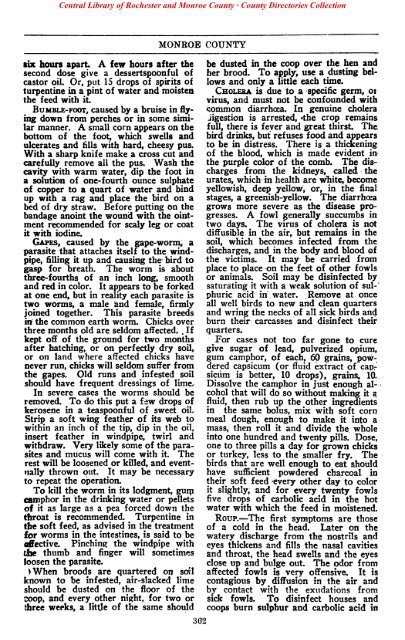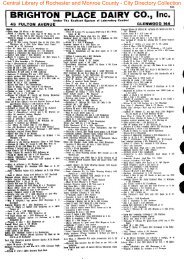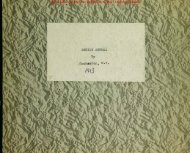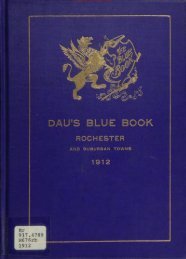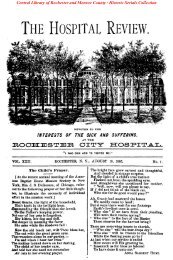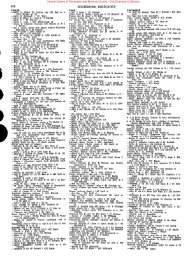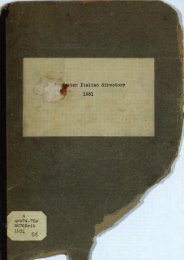The Farm Journal Illustrated Rural Directory of Monroe County, New ...
The Farm Journal Illustrated Rural Directory of Monroe County, New ...
The Farm Journal Illustrated Rural Directory of Monroe County, New ...
Create successful ePaper yourself
Turn your PDF publications into a flip-book with our unique Google optimized e-Paper software.
Central Library <strong>of</strong> Rochester and <strong>Monroe</strong> <strong>County</strong> · <strong>County</strong> Directories Collection<br />
six hours apart. A few hours after the<br />
second dose give a dessertspoonful <strong>of</strong><br />
castor oil. Or, put 15 drops <strong>of</strong> spirits <strong>of</strong><br />
turpentine in a pint <strong>of</strong> water and moisten<br />
the feed with it<br />
BUMBLE-FOOT, caused by a bruise in flying<br />
down from perches or in some similar<br />
manner. A small corn appears on the<br />
bottom <strong>of</strong> the foot, which swells and<br />
ulcerates and fills with hard, cheesy pus.<br />
With a sharp knife make a cross cut and<br />
carefully remove all the pus. Wash the<br />
cavity with warm water, dip the foot in<br />
a solution <strong>of</strong> one-fourth ounce sulphate<br />
<strong>of</strong> copper to a quart <strong>of</strong> water and bind<br />
up with a rag and place the bird on a<br />
bed <strong>of</strong> dry straw. Before putting on the<br />
bandage anoint the wound with the ointment<br />
recommended for scaly leg or coat<br />
it with iodine.<br />
GAPES, caused by the gape-worm, a<br />
parasite that attaches itself to the windpipe,<br />
filling it up and causing the bird to<br />
gasp for breath. <strong>The</strong> worm is about<br />
three-fourths <strong>of</strong> an inch long, smooth<br />
and red in color. It appears to be forked<br />
at one end, but in reality each parasite is<br />
two worms, a male and female, firmly<br />
MONROE COUNTY<br />
joined together. This parasite breeds<br />
hi the common earth worm. Chicks over<br />
three months old are seldom affected. . If<br />
kept <strong>of</strong>f <strong>of</strong> the ground for two months<br />
after hatching, or on perfectly dry soil,<br />
or on land where affected chicks have<br />
never run, chicks will seldom suffer from<br />
the gapes. Old runs and infested soil<br />
should have frequent dressings <strong>of</strong> lime.<br />
In severe cases the worms should be<br />
removed. To do this put a few drops <strong>of</strong><br />
kerosene in a teaspoonful <strong>of</strong> sweet oil.<br />
Strip a s<strong>of</strong>t wing feather <strong>of</strong> its web to<br />
within an inch <strong>of</strong> the tip, dip in the oil,<br />
insert feather in windpipe, twirl and<br />
withdraw. Very likely some <strong>of</strong> the parasites<br />
and mucus will come with it. <strong>The</strong><br />
rest will be loosened or killed, and eventually<br />
thrown put. It may be necessary<br />
to repeat the operation.<br />
To kill the worm in its lodgment, guin<br />
camphor in the drinking water or pellets<br />
<strong>of</strong> it as large as a pea forced down the<br />
throat is recommended. Turpentine in<br />
the s<strong>of</strong>t feed, as advised in the treatment<br />
for worms in the intestines, is said to be<br />
affective. Pinching the windpipe with<br />
the thumb and finger will sometimes<br />
loosen the parasite.<br />
>When broods are quartered on soil<br />
known to be infested, air-slacked lime<br />
should be dusted on the floor <strong>of</strong> the<br />
coop, and every other night, for two or<br />
three weeks, a little <strong>of</strong> the same should<br />
3G2<br />
be dusted in the coop over the hen and<br />
her brood. To apply, use a dusting bellows<br />
and only a little each time.<br />
CHOLERA is due to a specific germ, 01<br />
virus, and must not be confounded with<br />
common diarrhoea. In genuine cholera<br />
digestion is arrested, -the crop remains<br />
full, there is fever and great thirst. <strong>The</strong><br />
bird drinks, but refuses food and appears<br />
to be in distress. <strong>The</strong>re is a thickening<br />
<strong>of</strong> the blood, which is made evident in<br />
the purple color <strong>of</strong> the comb. <strong>The</strong> discharges<br />
from the kidneys, called the<br />
urates, which in health are white, become<br />
yellowish, deep yellow, or, in the final<br />
stages, a greenish-yellow. <strong>The</strong> diarrhoea<br />
grows more severe as the disease progresses.<br />
A fowl generally succumbs in<br />
two days. <strong>The</strong> virus <strong>of</strong> cholera is not<br />
diffusible in the air, but remains in the<br />
soil, which becomes infected from the<br />
discharges, and in the body and blood <strong>of</strong><br />
the victims. It may be carried from<br />
place to place on the feet <strong>of</strong> other fowls<br />
or animals. Soil may be disinfected by<br />
saturating it with a weak solution <strong>of</strong> sul-'<br />
phuric acid in water. Remove at once<br />
all well birds to new and clean quarters<br />
and wring the necks <strong>of</strong> all sick birds and<br />
burn their carcasses and disinfect their<br />
quarters.<br />
For cases not too far gone to cure<br />
give sugar <strong>of</strong> lead, pulverized opium,<br />
gum camphor, <strong>of</strong> each, 60 grains, powdered<br />
capsicum (or fluidextract <strong>of</strong> cap,-<br />
sicum is better, 10 drops), grains, 10.<br />
Dissolve the camphor in just enough alcohol<br />
that will do so without making it a.<br />
fluid, then rub up the other ingredients<br />
in the same bolus, mix with s<strong>of</strong>t corn<br />
meal dough, enough to make it into a<br />
mass, then roll it and divide the. whole<br />
into one hundred and twenty pills. Dose,<br />
one to three pills a day for grown chicks<br />
or turkey, less to the smaller fry. <strong>The</strong><br />
birds that are well enough to eat should<br />
have sufficient powdered charcoal, in<br />
their s<strong>of</strong>t feed every other day to color<br />
it slightly, and for every twenty fowls<br />
five drops <strong>of</strong> carbolic acid in the hot<br />
water with which the feed in moistened.<br />
ROUP.—<strong>The</strong> first symptoms are those<br />
<strong>of</strong> a cold in the head. Later on the<br />
watery discharge from the nostrils and<br />
eyes thickens and fills the nasal cavities<br />
and throat, the head swells and the eyes<br />
close up and bulge out. <strong>The</strong> odor from<br />
affected fowls is very <strong>of</strong>fensive. It is<br />
contagious by diffusion in the air and<br />
by contact with the exudations from<br />
sick fowls. To disinfect houses and<br />
coops burn sulphur and carbolic acid in


